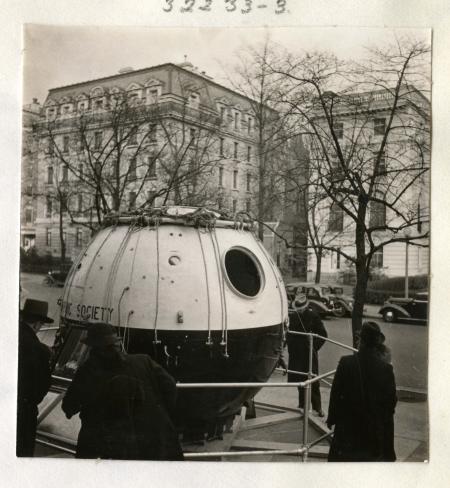Have you ever come across a photograph of an event which appears to be a unique and memorable experience, but which isn’t found in any of your record books? Here at the Archives we process a great number of images which lend themselves easily to research and investigation, but every so often we are just plain stumped. Here’s our latest case:

This photograph was taken by Ruel P.Tolman, former Director of Smithsonian National Collection of Fine Arts [now the Smithsonian American Art Museum], and is included in a scrapbook of photographs of Smithsonian staff, grounds and buildings, exhibitions, and Washington D.C. scenes. We’ve asked for your help identifying individuals in Tolman’s scrapbooks before, and now we’re coming to you for help identifying this event.
This is a photograph of a pressurized gondola sitting on display in the streets of D.C. (we don’t know exactly where, but we would like to!). This gondola appears to be one of the two Explorer vessels operated by the National Geographic Society and the U.S. Army Air Corps. These gondolas were used to study radiation and cosmic rays in the atmosphere at altitudes of 50,000 to 63,000 feet. Auguste Piccard launched the first study using a pressurized aluminum gondola in 1931, and by 1936 the Army Air Corps had developed and launched stratosphere expeditions, Explorer on July 27, 1934 and Explorer II on November 11, 1935.
On the body of the vessel, we can see a partial marking of ‘PHIC SOCIETY,’ which in full probably read ‘NATIONAL GEOGRAPHIC SOCIETY.’ In the photo directly below this marking is an illustrated panel which appears to depict the vessel in use, hanging on long lead lines which would have been attached to a gigantic balloon. There are two other photographs on this page of Tolman’s scrapbook. They are both of the interior of Constitution Hall, owned and operated by the Daughters of the American Revolution. Pencil inscriptions in the full scrapbook page read "Lincoln Ellsworth Lecture April 15, 1936" and "National Geographic."
On April 15, 1936, the Antarctic explorer Lincoln Ellsworth was awarded the National Geographic Hubbard Medal, presented by President Franklin D. Roosevelt. Following the presentation of the medal, Ellsworth delivered a lecture on April 15, 1936 in Constitution Hall. The content of the lecture was published under Ellsworth’s name as "My Flight Across the Antarctic," in the July 1936 issue of National Geographic Magazine.
The thing of it is, Lincoln Ellsworth explored the Antarctic by plane, not by balloon. In his 1939 account, “My Four Antarctic Expeditions,” Ellsworth makes no mention of experience with either of these gondolas. So what’s the connection?
Here are the questions you can help us with in uncovering the context of the photo:
Do you (or someone you know) remember an exhibition of either Explorer or Explorer II in Washington? Does this street look familiar to you? Locations can tell us a lot about an event.
Thank you for any help you provide and we wish you the best of luck in solving this mystery!
Related Resources
- Ruel P. Tolman’s Images: Who Are You?, The Bigger Picture blog, Smithsonian Institution Archives
Related Collections
- Record Unit 7433 - Ruel P. Tolman Collection, 1909-1964, Smithsonian Institution Archives
- National Geographic Society Hubbard Medal - Lincoln Ellsworth medal, National Air and Space Museum
- LTA, Balloons, USA, "Explorer II" (Nov 1935); Stevens, Albert William (Capt); Anderson, Orvil A. (Lt), by Rise Studio photographer, 1935, Archives Division, National Air and Space Museum
Produced by the Smithsonian Institution Archives. For copyright questions, please see the Terms of Use.

Leave a Comment